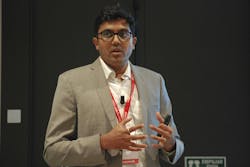Plant design, control and optimization reduce production costs
The green hydrogen sector’s biggest hurdle is in production costs, driven by operational inefficiencies, electrolyzer degradation and difficulties in power forecasting. Honeywell’s Plant Design and Unified Control and Optimization systems are designed to orchestrate multiple operations and improve plant efficiency while reducing capital expenditures (CapEx) and operating expenses (OpEx).
The current installed capacity of green hydrogen is very small but is expected to grow exponentially, predicted Swapnil Adkar, director, offering management, Honeywell Process Solutions, who spoke this week during the Honeywell Users Group (HUG) meeting in Madrid. “From 2023 to 2030, there are 865 projects which have been announced, excluding demonstration projects.”
In 2023, green hydrogen installed capacity was only 1.1 GW, said Adkar, but the optimistically estimated installed green hydrogen capacity for 2028 is 85 GW.
China, which already has the largest installed capacity with 70% of the global total, Europe, India and Australia are the hotbeds for green hydrogen projects, while the United States is emerging as a key area of activity. The levelized cost of hydrogen (LCOH), which measures lifetime costs divided by production, was $4.5/kg in 2019. “LCOH is a key concern for green hydrogen producers, and their key focus is to reduce LCOH to less than $2/kg of hydrogen. By the end of this decade, it’s expected to be about $2.6 or $2.7,” said Adkar.
One of the top challenges for green hydrogen plants lies in forecasting the cost of electricity for production. “Green hydrogen is expected to use renewable power, which is not a flat curve, so there are variations in the power profile,” explained Adkar. Energy storage management is another concern. “Eventually the cost of storage will come down, and energy storage will become part of these systems,” he assured the audience.
Design, control and optimization
Honeywell’s portfolio of green hydrogen plant offerings is broad. From Level 0 instrumentation and analyzers to Level 4 design and optimization tools, solutions are available that reduce CapEx and LCOH at the concept stage as well as reduce ongoing OpEx and maintenance costs. Adkar highlighted three specific offerings in his presentation—Concept Design and Optimization; Plantwide Control and Optimization; and Electrolyzer Control System.
Concept Design and Optimization software takes external and user inputs, such as weather services, carbon intensity calculation and constraints, cases and objectives, into the design and optimization engine for green hydrogen plant design and optimization and create a dashboard and reports for analysis, design, bill of materials and financials.
Fast techno-commercial proposals and decisions can be made with the information and insights from the dashboards and reports. Power intermittency and carbon intensity can be addressed. It spans the value chain from grid to gate, making it flexible for wide design scenarios. And it optimizes design for objectives and carbon intensity targets over a lengthy time horizon. This reduces CapEx and LCOH at the concept stage.
Plantwide Control and Optimization reduces operating expenses and maintenance costs, ensures compliance with regulations and enables financial incentives. Across the value chain, the electrical cost is the largest of the operating expenses. The solution has the intelligence to make complex decisions at spec regarding energy mix, curtailment, carbon intensity management, inventory management and electrolyzer life optimization. “It deals with all of the complexities of a green hydrogen plant,” said Adkar.
The Honeywell Electrolyzer Control System is designed to improve electrolyzer performance and extend life when integrated with the Honeywell Optimizer. “This will be useful for the plant to know how quickly these electrolyzers are degrading,” explained Adkar. “It will also integrate with electrical systems, battery energy storage systems, analyzers and optimization systems. Electrolyzer degradation over time affects the performance prediction. And, in multiple electrolyzer stacks, startup/shutdown sequences need to be managed. When you have early or late hours of operation of solar, electrolyzer operation is affected.”
About the Author
Mike Bacidore
Control Design
Mike Bacidore is chief editor of Control Design and has been an integral part of the Endeavor Business Media editorial team since 2007. Previously, he was editorial director at Hughes Communications and a portfolio manager of the human resources and labor law areas at Wolters Kluwer. Bacidore holds a BA from the University of Illinois and an MBA from Lake Forest Graduate School of Management. He is an award-winning columnist, earning multiple regional and national awards from the American Society of Business Publication Editors. He may be reached at [email protected]

Leaders relevant to this article:

